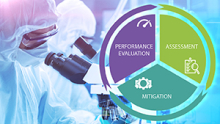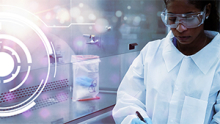Clinical Laboratory Improvement Amendments (CLIA) and Provider Performed Microscopy (PPM) Procedures: An Introduction
Important Notice
The Clinical Laboratory Improvement Amendments (CLIA) and Provider Performed Microscopy (PPM) Procedures: An Introduction eLearning course is being updated to reflect the regulatory changes indicated by the Clinical Laboratory Improvement Amendments of 1988 (CLIA) Fees; Histocompatibility, Personnel, and Alternative Sanctions for Certificate of Waiver Laboratories final rule. P.A.C.E.® credit for this course expires on July 31, 2025. If you register for the course prior to the expiration date, you can complete it and obtain a P.A.C.E®. certificate. Following that date, this course will be removed from OneLab REACH and replaced with a new course upon its completion.
Description
The goal of this eLearning course is to prepare physicians, midlevel providers, dentists, and others to meet requirements for PPM procedures under a CLIA certificate.
This basic-level eLearning course provides information on selected topics, including: background of PPM procedures, overview of criteria, examinations, and regulations, how to apply for a CLIA Certificate for PPM Procedures, requirements for PPM personnel, and additional CLIA requirements and quality practices.
Audience
This course is intended for physicians, midlevel practitioners including nurse midwives, nurse practitioners, and physician assistants, dentists, laboratory directors, and other laboratory professionals who:
- Perform PPM procedures
- Have a general knowledge of CLIA
- Have experience performing microscopic procedures
Accessibility
Course content is closed captioned, where applicable, and optimized for a screen reader.
Objectives
At the end of this course, learners should be able to:
- Describe the microscopic examinations a laboratory or testing site can perform under a CLIA Certificate for PPM procedures
- Describe the personnel requirements for performing PPM procedures
- Recognize your role, responsibilities, and scope of practice as a team member performing PPM procedures
- Identify components of quality practices for PPM procedures
Continuing Education (CE)
The Centers for Disease Control and Prevention, Division of Laboratory Systems is approved as a provider of continuing education programs in the clinical laboratory sciences by the ASCLS P.A.C.E.® Program. This course is approved for 1.0 contact hour of P.A.C.E.® credit.
P.A.C.E.® Course Number: 288-016-23.
Introduction to Laboratory Risk Management (LRM)
Description
Introduction to Laboratory Risk Management (LRM) is the first in a series of courses focused on developing risk management strategies for laboratory settings. This basic level eLearning course provides details on applying risk management principles and briefly describes related practices to emphasize the importance of risk management in laboratory settings. Topics covered include risk management goals, terminology, processes, and associated activities.
Audience
This online course is designed for new or existing public health and clinical laboratory professionals who handle potentially hazardous materials.
Accessibility
Course content is closed captioned, where applicable, and optimized for a screen reader.
Objectives
At the end of this course, learners should be able to:
- Recognize the importance and benefits of risk management.
- Define terms associated with risk management.
- List the major processes in risk management and associated activities.
- Identify the importance of ensuring dynamic continual improvement.
Continuing Education (CE)
The Centers for Disease Control and Prevention, Division of Laboratory Systems is approved as a provider of continuing education programs in the clinical laboratory sciences by the ASCLS P.A.C.E.® Program. This course is approved for 1.0 contact hour(s) of P.A.C.E.® credit.
P.A.C.E.® Course Number: 288-006-23.
Introduction to Clinical Laboratory Improvement Amendments (CLIA) of 1988
Description
The goal of this course is to equip learners with foundational information about CLIA, including the history, its importance, and implications for clinical laboratories and facilities that perform testing that are subject to the regulations.
This basic-level eLearning course provides information on selected CLIA regulations. Topics covered include CLIA Regulatory Program Overview, CLIA Laboratory Testing and Quality Standards, and CLIA Program Oversight and Administration.
Audience
This online course is designed for anyone who has a role associated with clinical laboratory testing, including those conducting tests or overseeing the testing process. This audience includes laboratory professionals, physicians, nurses, pharmacists, midlevel practitioners, including nurse midwives, nurse practitioners, and physician assistants, and those who perform testing at non-laboratory sites.
Accessibility
Course content is closed captioned, where applicable, and optimized for a screen reader.
Objectives
At the end of this course, learners should be able to:
- Describe the background and fundamental concepts of the Clinical Laboratory Improvement Amendments of 1988 (CLIA) Law and Regulatory Program
- Recall CLIA certification requirements for clinical laboratory testing
- Identify the important components of the quality system standards supporting CLIA regulations
- Recall the roles of federal agencies that support the CLIA program
- Describe your role and responsibilities as a team member associated with clinical laboratory testing, including conducting tests or supporting other activities related to the clinical testing process for obtaining a CLIA certificate
Continuing Education (CE)
The Centers for Disease Control and Prevention, Division of Laboratory Systems is approved as a provider of continuing education programs in the clinical laboratory sciences by the ASCLS P.A.C.E.® Program. This course is approved for 1.5 contact hours of P.A.C.E.® credit.
P.A.C.E.® Course Number: 288-015-23.
See CDC Course Accreditation document in the left box for more details.
To receive Continuing Medical Education (CME), Continuing Nurse Education (CNE), or Continuing Education Units (CEU), follow the steps below by January 14, 2026.
1. Complete the course in OneLab REACH.
2. Pass the posttest at 80%.
3. Copy the passcode provided after passing the posttest.
4. Go to CDC TRAIN and register for the Introduction to Clinical Laboratory Improvement Amendments of 1988 - WB4497R
5. Check the box for each type of CE you wish to apply for when registering for the course.
6. Select the **Mark Completed** button on the course page in TRAIN.
7. Enter the passcode when prompted.
8. Complete the evaluation in CDC TRAIN.
You can access your CME, CNE, or CEU cetificates and transcript by visiting **Your Learning** in TRAIN.
Fundamentals of Working Safely in a Biological Safety Cabinet (BSC)
P.A.C.E.® credit for this course expires on May 31, 2025. If you register for the course prior to the expiration date, you can complete it and obtain a P.A.C.E®. certificate. If you register after the expiration date, you can obtain a general certificate of completion.
Description
A biological safety cabinet (BSC) is the primary means of containment developed for working safely with infectious microorganisms. Class II BSCs, the most common cabinets used in laboratories, are designed to provide personnel protection (for you and those around you), product protection (for your samples), and environmental protection.
This basic-level eLearning course provides information on the safe use of Class II biological safety cabinets. Topics covered include major parts of a BSC, how a BSC works, how to work safely inside a BSC, and what to do if there is an emergency while working in a BSC. Videos, interactive exercises, job aids, and a modifiable checklist template are included in the course to enhance the learning experience.
Audience
This online course is designed for public health and clinical laboratory staff, safety professionals, and persons interested in the safe use of biological safety cabinets.
Accessibility
Course content is closed captioned, where applicable, and optimized for a screen reader.
Objectives
At the end of this course, learners should be able to:
- Identify the major parts of a Class II BSC
- Discuss general facts about BSCs
- List the factors that affect BSC airflow
- Describe the preparation steps for work in a BSC
- Describe the practices for working safely in a BSC
- Describe the steps for completion of work in a BSC
- Describe the BSC procedures to follow in an emergency
Continuing Education (CE)
The Centers for Disease Control and Prevention, Division of Laboratory Systems is approved as a provider of continuing education programs in the clinical laboratory sciences by the ASCLS P.A.C.E.® Program. This course is approved for 1.0 contact hours.
P.A.C.E.® Course Number: 288-002-23
Fundamentals of Personal Protective Equipment (PPE) in Clinical Laboratories
Description
Safety is imperative when working with potentially harmful materials and other hazards in the laboratory. This course is designed to assist clinical and public health laboratory professionals with applying risk management strategies to identify hazards, assess risks, and select appropriate personal protective equipment (PPE) options.
Audience
This basic level course is designed for new or existing public health and clinical laboratory professionals who handle potentially hazardous materials.
Accessibility
Course content is closed captioned, where applicable, and optimized for a screen reader.
Objectives
At the end of this course, learners should be able to:
- Describe how PPE helps protect laboratory professionals.
- Recognize the hazards and risks associated with laboratory procedures.
- Identify options, limitations, and considerations for selecting appropriate PPE.
- Select appropriate PPE options for given clinical laboratory scenarios.
Continuing Education (CE)
The Centers for Disease Control and Prevention, Division of Laboratory Systems is approved as a provider of continuing education programs in the clinical laboratory sciences by the ASCLS P.A.C.E.® Program. This course is approved for 1.0 contact hours.
P.A.C.E.® Course Number: 288-024-24.
Fundamentals of Chemical Fume Hood Safety
Description
A chemical fume hood is the main piece of laboratory equipment that protects laboratory staff working with hazardous chemicals. When properly used, fume hoods protect staff from inhaling chemical gases, vapors, and aerosols. They serve as a physical barrier between staff and the hazardous materials inside the hood, and provide some splash protection.
This basic-level eLearning course provides an essential understanding of the major components of a chemical fume hood and proper practices for its safe and effective operation. Topics covered include the major components and types of fume hoods and their monitors, maintaining proper airflow, daily use protocols and good fume hood work practices, and what to do if there is an emergency.
Audience
This online course is designed for public health and clinical laboratory staff, safety professionals, and persons interested in the safe use of chemical fume hoods as determined by your laboratory-specific risk assessment.
Accessibility
Course content is closed captioned, where applicable, and optimized for a screen reader.
Objectives
At the end of this course, learners should be able to:
- Identify general facts about fume hoods
- List factors that affect the proper fume hood airflow
- Describe startup procedures prior to working in a fume hood
- Describe proper practices for working in a fume hood
- Describe cleanup procedures for completion of work in a fume hood
- Describe the procedures to follow during an emergency
Continuing Education (CE)
The Centers for Disease Control and Prevention, Division of Laboratory Systems is approved as a provider of continuing education programs in the clinical laboratory sciences by the ASCLS P.A.C.E.® Program. This course is approved for 1.0 contact hours.
P.A.C.E.® Course Number: 288-028-24
Fundamentals of Centrifuge Safety
Description
Centrifuges are instruments used to separate mixtures, based on particle size and density, by spinning the mixtures at high speeds. These instruments are essential tools in all types of laboratories. Serious injuries or potential exposures can occur if centrifuges are improperly used or maintained.
This basic-level eLearning course provides information on the safe use of centrifuges. Topics covered include major parts of a centrifuge, types of centrifuges, potential hazards, how to work safely with a centrifuge, and what to do if there is an emergency.
Audience
Public health and clinical laboratory staff, safety professionals and persons interested in safe use of centrifuges.
Accessibility
Course content is closed captioned, where applicable, and optimized for a screen reader.
Objectives
At the end of this course, learners should be able to:
- Identify common types of centrifuges used in laboratories
- Describe the potential hazards associated with centrifuge use
- Identify control measures to minimize exposure to centrifuge hazards
- Identify safe work practices for centrifuge use
- Describe what to do in the event of an emergency
Continuing Education (CE)
The Centers for Disease Control and Prevention, Division of Laboratory Systems is approved as a provider of continuing education programs in the clinical laboratory sciences by the ASCLS P.A.C.E.® Program. This course is approved for 0.5 contact hours.
P.A.C.E.® Course Number: 288-025-24
Basic Molecular Biology Module 4: Polymerase Chain Reaction (PCR) and Real-Time PCR
Disclaimer:
P.A.C.E.® credit for this course expires on September 30, 2025. If you register for the course prior to the expiration date, you can complete it and obtain a P.A.C.E®. certificate. If you register after the expiration date, you can obtain a general certificate of completion.
Description
Molecular techniques have been widely used in clinical diagnosis, e.g., diagnosing disease, predicting disease course, and identifying infectious agents. This basic molecular biology course series will introduce the scientific background for molecular diagnosis, the principles of molecular biology laboratory practice, and common methods.
This basic-level eLearning course provides information on the principle of PCR and real-time PCR. Topics covered include PCR steps, PCR product analysis, and real-time PCR characteristics.
Audience
This online course is designed for public health and clinical laboratory staff, and persons interested in PCR and real-time PCR techniques.
Accessibility
Course content is closed captioned, where applicable, and optimized for a screen reader.
Objectives
At the end of this course, learners should be able to:
- Explain the basic steps involved in PCR
- Identify the components of PCR, reverse transcription PCR, and PCR product analysis
- Recognize the characteristics of real-time PCR
- Identify the techniques used to detect products in real-time PCR
- Differentiate the nucleic acid quantification processes used in real-time PCR
- Explain the roles of PCR controls
Continuing Education (CE)
The Centers for Disease Control and Prevention, Division of Laboratory Systems is approved as a provider of continuing education programs in the clinical laboratory sciences by the ASCLS P.A.C.E.® Program. This course is approved for 1.0 contact hours. P.A.C.E.® Course Number: 288-011-23.
Basic Molecular Biology Module 3: Nucleic Acid Extraction
P.A.C.E.® credit for this course expires on July 31, 2025. If you register for the course prior to the expiration date, you can complete it and obtain a P.A.C.E®. certificate. If you register after the expiration date, you can obtain a general certificate of completion.
Description
Molecular techniques have been widely used in clinical diagnosis, e.g., diagnosing disease, predicting disease course, and identifying infectious agents. This basic Molecular Biology course series will introduce the scientific background for molecular diagnosis, the principles of molecular biology laboratory practice, and common methods.
This basic-level eLearning course, Module 3, provides information on nucleic acid extraction. Topics covered include extraction method selection, basic extraction steps, and nucleic acid analysis.
Audience
This online course is designed for public health and clinical laboratory staff and persons interested in nucleic acid extraction.
Accessibility
Course content is closed captioned, where applicable, and optimized for a screen reader.
Objectives
At the end of this course, learners should be able to:
- Identify the four major factors used in selection of the nucleic acid extraction method
- Outline the three basic steps in nucleic acid extraction
- Explain how to analyze nucleic acid quantity and purity by spectrophotometry and gel electrophoresis
- Identify common problems in nucleic acid extraction
Continuing Education (CE)
The Centers for Disease Control and Prevention, Division of Laboratory Systems is approved as a provider of continuing education programs in the clinical laboratory sciences by the ASCLS P.A.C.E.® Program. This course is approved for 1.0 contact hours.
P.A.C.E.® course number: 288-010-23.
Basic Molecular Biology Module 2: Laboratory Practice
Description
Molecular techniques have been widely used in clinical diagnosis, e.g., diagnosing disease, predicting disease course, and identifying infectious agents. This basic molecular biology course series will introduce the scientific background for molecular diagnosis, the principles of molecular biology laboratory practice, and common methods.
This basic-level eLearning course provides information on general laboratory practices. Topics covered include biosafety practices, laboratory area flow, and practices to minimize contamination.
Audience
This online course is designed for public health and clinical laboratory staff and persons interested in molecular biology laboratory practice.
Accessibility
Course content is closed captioned, where applicable, and optimized for a screen reader.
Objectives
At the end of this course, learners should be able to:
- Identify the general practices and biohazards associated with performing molecular biology procedures in BSL-1 and BSL-2 laboratories
- Explain the differences of the working areas needed to perform procedures in molecular biology
- Outline the unidirectional workflow used to minimize contamination in the laboratory
- Identify general decontamination practices in the molecular biology laboratory
Continuing Education (CE)
The Centers for Disease Control and Prevention, Division of Laboratory Systems is approved as a provider of continuing education programs in the clinical laboratory sciences by the ASCLS P.A.C.E.® Program. This course is approved for 1.0 contact hours.
P.A.C.E.® Course Number: 288-022-23
Pagination
- Previous page
- Page 2
- Next page










